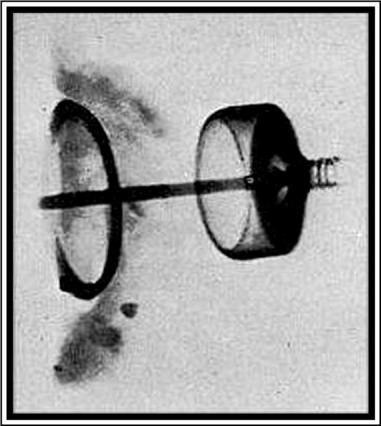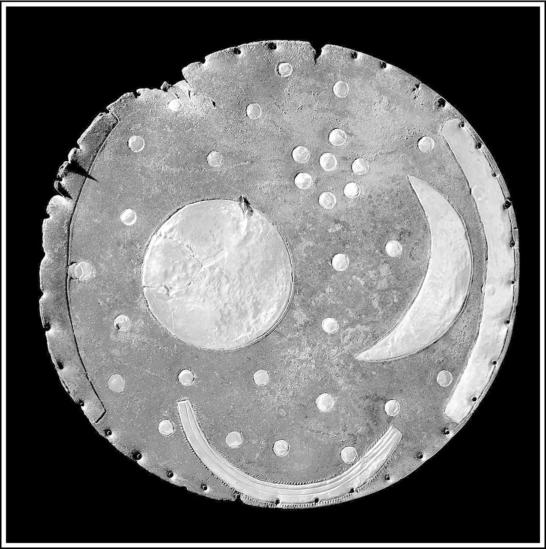Hidden History: Lost Civilizations, Secret Knowledge, and Ancient Mysteries (30 page)
Read Hidden History: Lost Civilizations, Secret Knowledge, and Ancient Mysteries Online
Authors: Brian Haughton
Tags: #Fringe Science, #Gnostic Dementia, #U.S.A., #Alternative History, #Amazon.com, #Retail, #Archaeology, #History

unknown technology from millennia
before the accepted emergence of
Homo sapiens, then obviously it would
turn accepted thought about the past
of the human species on its head.
The only other person known to
have physically inspected the artifact
was creationist Ron Calais, who was
allowed to take photographs of the
nodule in both X ray and normal light.
The X ray of the upper end of the object revealed that the metallic shaft
was attached to what looked similar
to some kind of tiny spring. This led
to the object being categorized as some
type of electrical mechanism. Paul
Willis, publisher of paranormal magazine INFO Journal, examined the X
rays of the mysterious artifact and concluded that it could be "the remains of
a corroded piece of metal with
threads," and noted the similarity between the object and a modern spark
plug. In 1963, the artifact was apparently displayed for three months at the
Eastern California Museum in Independence. The spring 1969 issue of
INFO Journal stated that Wallace
Lane, one of the original discoverers of
the object, was then its owner, and that
it was on display in his home. Lane
steadfastly refused permission for anyone to examine it, but was reportedly
offering to sell it for $25,000. Some time
after 1969, the Coso Artifact seems to
have disappeared. In September 1999,
a national search undertaken to trace
any of the original discoverers proved
unsuccessful. It seems likely that by
then Lane had died and the whereabouts of Mikesell were unknown. To
this day, Virginia Maxey, who is known
to be still living, refuses to comment
publicly about the artifact, the location
of which remains unknown.
Curiously enough, INFO Journal
editor Paul J. Willis has conjectured
that the artifact was some kind of
spark plug, but was unable to understand the function of the spring on the
object, which did not match up with
contemporary spark plugs. Around the
time of the original discovery of the
Coso Artifact, Virginia Maxey speculated that it was possible that the object was a mere 100 years old. She
thought that if it had lain in a mud
bed, and afterwards become baked and
hardened by the sun, it could have
ended up in the condition in which they
found it. But it was also Maxey who
stated that the artifact was possibly
500,000 years old and "an instrument
as old as legendary Mu or Atlantis.
Perhaps it is a communications device
or some sort of directional finder or
some instrument made to utilize power
principles we know nothing about."
Thus began the fantastic speculations
about the artifact.
The crux of the mystery seems to
be that the object was found encased
in a 500,000-year-old geode, which included fossil shells. However, the exterior of the object was mainly
composed of hardened clay with a mixture of organic matter, whilst a geode
has an outer shell composed of dense
chalcedonic silica. When broken open
by Mike Mikesell the day after the discovery, the inside of the object proved
to be of a different composition to that
of a geode; it did not possess a hollow
center filled with a layer of quartz crystals, as with most geodes. However,
this still leaves the problem of what
fossil shells were doing encrusted into
the surface of the object. But the value
of these fossil shells for dating the object is negligible if one remembers the
original discoverers identified a nail
and washer on the same surface as the
fossil shells.

X ray of the Coso Artifact.
Because of the mystery surrounding its whereabouts, and the lack of a
published report on the object, speculation is rife about the Coso Artifact.
A mechanical object encased in a geode apparently more than half a million years old. How had it gotten there?
Was it the product of some unimaginably ancient technologically-advanced
culture, all traces of which have now
disappeared? The Internet has many
Websites that include speculations on
the purpose and origin of the mechanism, while offering no new evidence
to support their claims. Opinions on
its function include a super-antenna,
a small capacitor, or an ancient spark
plug. The latter suggestion is the
most widespread: a spark plug produced by an advanced civilization as
part of some mysterious technological
apparatus.
Investigations into the origins of
the Coso Artifact by writer Pierre
Stromberg and geologist Paul V.
Heinrich discovered that mining operations were being carried out in the
Coso Mountains early in the 20th century. Perhaps, they conjectured, internal combustion engines were being
used in these operations, and the ancient spark plug proponents might
have been at least partly right after
all. In order to test their tentative
theory, the duo attempted to have the
object identified by contacting an organization known as the Spark-Plug
Collectors of America. They sent letters and copies of X rays of the artifact
to four different spark-plug collectors,
who had no knowledge of the case and
had never seen the pictures before. The
collectors independently came to the
same conclusion-they were certain
that it was a 1920s era Champion spark
plug, one that probably powered a Ford
Model T, and had possibly been modified to serve the mining operations in
the Coso mountain range. The amount
of decay in the artifact was an almost
perfect match for the rates of decay
that would occur in a spark plug from
this era. So, the Coso Artifact had been
lying on the mountain for no more than
40 years.
It seems clear that the spark plug
was not actually embedded in rock, but
in an iron oxide nodule. The formation
of this nodule was probably accelerated by corrosive "mineral dust" blown
off of the dry lake bed of Lake Owen
by local windstorms, and onto the
neighboring uplands where the artifact was found.
The Coso Artifact is not the only
spark plug to have been found in a
strange place. The summer 1998 number of The Igniter, published by the
Spark-Plug Collectors of America, featured a discovery made while scuba
diving, of what looked like "a ball of
barnacles and shells," but with a spark
plug top sticking out of it. A spark
plug apparently embedded in a
melted lump of rock was washed up
on a beach in Delaware, but the "rock"
was found to be composed of a combination of mud and rust (as with the
Coso Artifact), the combination of
which, once baked solid in the sun,
became almost as hard as rock. In the
end the Coso Artifact is more a case
of wishful thinking (and at times, wilful secrecy) than an outright hoax.
There is no evidence that the original discoverers planned to deceive
anyone from the start, though they
may have thought otherwise as more
attention was placed on the object (as
Wallace Lane, offering the artifact for
sale at $25,000, suggests). Unfortunately, though it has been proved almost beyond doubt that this
controversial artifact is a 1920s spark
plug, it is still possible to surf the Inter-net and quite easily find Websites
using the Coso Artifact in support of
a theory of technically advanced civilizations in the impossibly remote
past.


©Landesamt fiirDenkmalpflege undArchaologie Sachsen-Anhalt (State Office for
Heritage Management and Archaeology Saxony-Anhalt), Juraj Liptak.
The Nebra Sky Disc.
The Nebra Sky Disc is one of the
most fascinating, and some would say
controversial, archaeological finds of
recent years. Dated to 1600 B.C., this
bronze disc has a diameter of 32 centimeter (about the size of a vinyl LP) and
weighs around 4 pounds. It is patinated
blue-green and embossed with gold leaf
symbols, which appear to represent a
crecent moon, the sun (or perhaps a
full moon), stars, a curved gold band
(interpreted as a sun boat), and a further gold band on the edge of the disc
(which probably represent one of the
horizons). Another gold band on the
opposite side is missing.
The object was discovered in 1999
by treasure hunters using a metal detector at a prehistoric enclosure encircling the Mittelberg hill, near the
town of Nebra in the Ziegelroda Forest, 112 miles southwest of Berlin,
Germany. Unfortunately, the treasure
hunters caused considerable damage
to the disc during its crude removal
from the ground, which included splintering its outer rim, losing one of the
stars, and chipping a large piece off the
gold disc. The looters subsequently
attempted to sell the disc, along with
two swords, two axes, a chisel, and
fragments of armlets, to local archaeologists. But they discovered that, by
law, the objects belonged to the state
of Sachsen-Anhalt, where they were
unearthed, so they could not be sold
legally. In February 2003, they tried
selling the disc to an antiquities collector in Switzerland for $400,000.
However, the collector was actually
working for the Swiss police as part of
a sting operation to trap the group,
which played out in the basement bar
of the Hilton hotel in Basle. The group
was subsequently arrested and the disc
was recovered. It is now the property
of the state of Sachsen-Anhalt.
The disc illustrates the crescent
moon, a sun or full moon, three arcs,
and 23 stars dotted around (apparently
at random). There is a further cluster
of seven stars, identified as the Pleiades constellation. X-rays have revealed
two more stars underneath the gold of
the right arc, suggesting that the two
arcs were added later than the other
features. The blue-green background
of the night sky was once colored a
deep violet-blue, apparently by applying rotten eggs, causing a chemical
reaction on the bronze surface. Running along the edge of the disc is a ring
of holes punched through the metal,
probably for attaching the disc to
something, perhaps a piece of heavy
cloth.
So what exactly is the Nebra Sky
Disc and what was it used for? Many
researchers believe it is the oldest
known realistic representation of the
cosmos yet found, perhaps a kind of
astronomical calculation tool to determine planting and harvest times. For
thousands of years, all across northern Europe, monuments were aligned
to mark the summer and winter solstices: Stonehenge in England, and
Newgrange in Ireland, are good examples. As Bronze Age people were an
agricultural society, a method for finding out the time of year (and thus the
correct times for planting and harvesting crops) was obviously vital. One way
of doing this was to identify the position of the sun at sunrise and sunset.
Intrigued by the possibility of the
Nebra Disc as an astronomical device,
Professor Wolfhard Schlosser of the
University of Bochum measured the
angle between the pair of arcs on either side of the disc, and found that it
was 82 degrees. Fascinatingly, at
Mittelberg hill, between the high midsummer sunset and the low midwinter sunset, the sun appears to
travel around 82 degrees along the
horizon. This angle would vary from
place to place. Further north, for example, it would be 90 degrees, and to
the south, 70. But in a restricted belt
of central Europe, the suns passage
across the sky measures precisely 82
degrees. Schlosser concluded that the
pair of arcs along the circumference of the Nebra Disk did indeed depict
the sun solstices accurately for its location. This would suggest that the
Bronze Age agricultural societies of
central Europe made sophisticated
celestial measurements far earlier
than has been suspected.